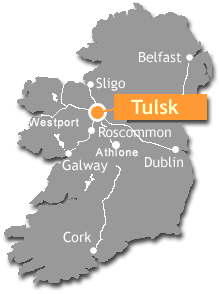The stone ringfort site at Cashelmanannan - Caiseal Mhanannán (literally "Manannán's Fort") is a feature of our complex that has a very complicated story. Its name was first recorded by John O'Donovan in 1837. To focus firstly on the place name, Manannán refers to Manannán mac Lir, a deity in Irish mythology that is associated with the sea. That in itself would provide us with a problem. However, the stories mentioning Manannán also give him a role as guide to the Otherworld, which, given the location of the monument in relation to our entrance to the Otherworld at Oweynagat (880 metres apart), goes some way to explaining its choice. Before theorising on the site's use, however, we will describe it's archaeology.
As it exists presently, Cashelmanannan is a trivallate stone fort, with only the foundations of the stone walls still visible, existing to a maximum height of approximately 50cm. The average width of these concentric walls, however, is 1.5m, implying that it would have been a very well-defended site during its period of use. The diameter of the inner enclosure is 40m, with the overall dimensions of the main enclosure being 57m north/south by 63m east/west. Attached to the main enclosure are two 'annexes', located to the north and east. Both are defined by a single bank. These have been variously described as small fields or agricultural enclosures in the literature, although their precise function can only be ascertained with excavation.
 |
| Aerial photograph of Cashelmanannan from the west (After Waddell et al. 2009, fig 6.7). Note the two 'annexes' attached to the main enclosure. |
So to the theories as to the function of Cashelmanannan. The traditional view associates the site with the conversion of two daughters of King Laoghaire of Tara, Eithne and Fidelma by St. Patrick. It is said that the two princesses were being educated at a druidic school, believed to be Cashelmanannan, and that Patrick baptised them at the nearby Ogulla Well, after which they died. The association of the site with the deity Manannán, evident in the place name, could help strengthen the case for this site being affiliated with druids. Its placement in relation to both the Mucklaghs and Oweynagat would further strengthen these links, if we interpret the feature in the middle being used as a ceremonial path- or procession way between both monuments.
An alternate view of the role and function of Cashelmanannan, however, can be seen in its construction. The fact that it is was a stone-built feature, with three concentric walls 1.5m wide, implies a very defensive role for the site. It is also the only stone-built monument on the complex. If we believe the evidence from medieval literature describing the 'royal residence' of Rathcroghan as a stone structure, there is a possibility that Cashelmanannan could have been less of a druid's school, and more of a residence for high-status individuals in the first millenium AD. A geophysical survey conducted on the site in 2010 uncovered anomalies usually associated with domestic and industrial activities,(Waddell et al, 2012) something which would make sense in a settlement context.
But what of the Mucklaghs? A reinterpretation of Cashelmanannan wouldn't necessarily disregard the importance of the linear earthworks known as the Mucklaghs. With Oweynagat being associated with warrior initiation ceremonies, the placement of the royal residence at the beginning of this ceremony would allow the Mucklaghs to retain its vital function linking the two monuments. Food for thought, perhaps...Daniel Curley
 |
| Cashelmanannan is located in the south-west corner of the map |
- Waddell, J., Schot, R., Fenwick, J., "The Connacht Project: Geophysical Survey at Rathcroghan, Co. Roscommon, 2012", (October, 2012)



No comments:
Post a Comment